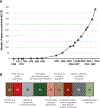Human inborn errors of immunity: An expanding universe
- PMID: 32651211
- PMCID: PMC7647049
- DOI: 10.1126/sciimmunol.abb1662
Human inborn errors of immunity: An expanding universe
Abstract
Molecular, cellular, and clinical studies of human inborn errors of immunity have revolutionized our understanding of their pathogenesis, considerably broadened their spectrum of immunological and clinical phenotypes, and enabled successful targeted therapeutic interventions. These studies have also been of great scientific merit, challenging a number of immunological notions initially established in inbred mice while revealing previously unrecognized mechanisms of host defense by leukocytes and other cells and of both innate and adaptive tolerance to self.
Copyright © 2020 The Authors, some rights reserved; exclusive licensee American Association for the Advancement of Science. No claim to original U.S. Government Works.
Conflict of interest statement
Figures




References
-
- Bruton OC, Agammaglobulinemia. Pediatrics 9, 722–728 (1952). - PubMed
-
- Glanzmann E, Riniker P, [Essential lymphocytophthisis; new clinical aspect of infant pathology]. Ann Paediatr 175, 1–32 (1950). - PubMed
-
- Hitzig WH, Biro Z, Bosch H, Huser HJ, [Agammaglobulinemia & alymphocytosis with atrophy of lymphatic tissue]. Helv Paediatr Acta 13, 551–585 (1958). - PubMed
-
- Hitzig WH, Barandun S, Cottier H, [The Swiss type of agammaglobulinemia]. Ergeb Inn Med Kinderheilkd 27, 79–154 (1968). - PubMed
-
- Cooper MD, A life of adventure in immunobiology. Annu Rev Immunol 28, 1–19 (2010). - PubMed
Publication types
MeSH terms
Grants and funding
LinkOut - more resources
Full Text Sources
Other Literature Sources

